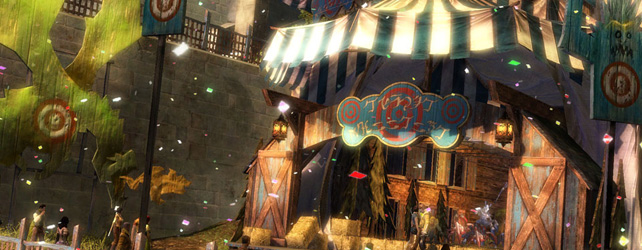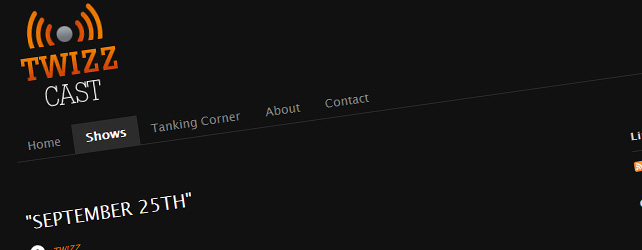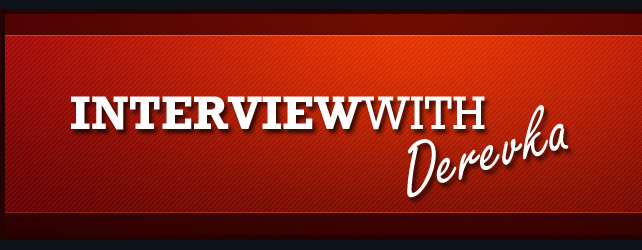I jumped on an opportunity to speak with Derevka about the upcoming expansion and his thoughts on the priest class in general. We chatted about the state of both healing specs, raiding encounters in Mists, and spell usage. Keep on reading for the full interview.
Matt: Hey Derevka, it’s been a while. You’ve recently picked up activity again on your blog, Tales of a Priest after taking a brief reprieve earlier in the year. You’ve especially been hard at work lobbying for some priest changes like Chakra and have put in some research on the mana regen talents. So what do you think is the biggest change for priests leaping from Cataclysm to Mists, in your opinion?
Derevka: Tricky question, since I’d argue that Priests were affected least by the onslaught of changes that came in MOP— at least from a class mechanic standpoint. For the most part our healing strategy will be ‘more of the same’. Perhaps the biggest change in Mists will be how we look at mana. First and foremost we need to realize that once we hit 90, we will not be getting any more mana. 300,000 is our pool. Period.
Mana pools, since they do not scale, will be something we need to really keep an eye on. For example, Greater Heal in quest greens costs the same amount of mana that it does in full epic T14. The only thing that will scale is our ability to regen mana via spirit. We will need to balance spirit and know when we have too much or too little. Mana is a zero-sum game.
Purely spamming Prayer of Healing will quickly have you running out of mana; we’ll need to be more mindful of what spells we choose to cast as well as how to use our mana cooldowns, and talents. It could be a steep learning curve for some who are too used to the Dragon Soul era of mana and are unfamiliar with mana management.
We’ll need to be more mindful of what spells we choose to cast as well as how to use our mana cooldowns, and talents.
M: Yeah, I found that out the hard way having to put Heal back in my bars again. Have you figured out any numbers for Spirit benchmarks or what we’ll need to hit at different stages of character progression? For example, how much are we going to need to adequately heal through heroic dungeons, challenge modes, or entry level raids?
D: Spirit numbers are tricky, as it really depends on your healing style. I will say that we’re going to want spirit on pretty much all of our gear in the first tier of raiding. Gone are the days of equipping non-spirit/dual stat gear!
For those who remember MP5 as a stat, think of spirit in that manner — it provides zero throughput: Just pure regen. We’ll have the ability to trade off spirit (via reforging) for throughput stats pretty easily, but it’ll depend on what your comfort level is. Personally, I would suggest being cautious with mana at first, and then pair back my regen instead of gasping for mana but my heals hit like a truck. It’ll be a fun balancing act, and will depend on individual healing style.

M: What do you feel is the go-to Priest spec?
D: Hard question as they both provide some great tools and flavor. If I had to knee-jerk a response, I am going to say Holy. Holy always does well early in an expansion as it is arguably the least reliant on combat stats of the two priest healing specs. I say this because Disc gets a good deal of it’s output from Divine Aegis. DA, apart from POH, is created by critical heals In low iLvl gear (aka Fresh 90’s) you’ll have innately lower crit chance due to less available Intellect on gear, and stats. Now, do not misconstrue me and say “Derevka said to stack crit as disc at 90!” … No, that’s not what I am saying. I am saying that you’ll innately have lower critical strike due to your intellect and available crit, thus causing the creation of Divine Aegis more difficult (ie. 5 mans).
M: With that in mind, what does Discipline need to get itself back up to comparable level with Holy?
I do not think Disc is in a bad place at all. I think that Holy will just have an easier time early in the level 90 gear grind, only because Disc has a more strict gear requirement than Holy. Disc will be very powerful, particularly since it still has Barrier and access to the new Spirit Shell. Spirit Shell could be one of “those abilities” that winds up getting nerfed when used “creatively”. I do worry that Spirit Shell will be used to bypass boss abilities. I mean, you have the ability to prep a tank with a 60% HP bubble– then PW: Shield on top of that, and if you wanted, Pain Suppression as well. Remember people using Guardian Spirit to avoid Valiona’s Blackout in Heroic Bastion of Twilight? This could potentially be used similarly. Time will tell. Spirit Shell is going to be perfect for those places where you would have POH/DA prepared the raid… except now, all that POH healing will be Spirit Shells!
I mean, you have the ability to prep a tank with a 60% HP bubble– then PW: Shield on top of that, and if you wanted, Pain Suppression as well.
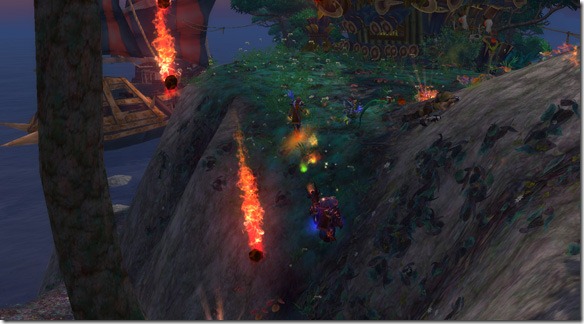
M: In a previous conversation, we were talking about Mastery and how the points have changed. Do you consider haste the primary secondary stat for Holy with Mastery and Crit right behind it? What about Discipline?
D: Yes, Mastery should be a bit more transparent when it comes to its benefits on the character sheet. It’ll be much easier to understand now that they have streamlined the stat conversion straight to percentage gained.
That said, it is hard to provide a concrete statweight since a number of our spells are in flux when it comes to combat stat ratings; specifically regarding what affects them and what does not. As of build 17882, we have Holy Word: Sanctuary now being affected by haste, which has me concerned, I did the math and its not good news– but it may be a bug. That said, since HW: Sanctuary is being affected by Haste, it does make breakpoints something to keep in mind. I have calculated the required Haste Rating for each Spell’s Breakpoint and will be publishing those numbers shortly. I do not think we’ll be ‘chasing breakpoints’ in MoP, but keeping them in mind will be critical–We’ll want to know where they are, so we can ensure we aren’t so close that we should change a gem or two. I do not think we’ll be gearing to get that additional HW: Sanctuary tick.
However, a Hymn tick on the other hand…
Preliminary simming is going to put Haste/Mastery pretty close to one another for Holy; however it will depend on how you heal. Are you going to be constantly spamming? Are you going to be weaving in more Power Word: Solaces? Are you going to burst heal and then slow down to regen? Are you single target healing? These all have different impacts to your statweights. If forced to chose, I would probably suggest gearing for enough Haste (raidbuffed) for the added Hymn (both), Renew tick and for a 10th Sanctuary tick… then Mastery. We’ll likely have a good deal of mastery since a lot of the cloth drops and craftables are covered in it!
Discipline will enjoy Mastery since it now has a 3rd spell that benefits from it: Spirit Shell. Power Word: Shield, Divine Aegis, and Spirit Shell will all scale from Mastery. More simming will be needed to be done to get these stats, but for the most part Haste & Mastery will likely be our top go-to stats.
For the most part Haste & Mastery will likely be our top go-to stats.
M: Level 90 talents. What do you think about each of them and what’s going to be your standard level 90 talent?
D: For raiding? Hands down, Cascade. I like them all (even beyond just the visuals). Halo is nice, but requires too much positional tweaking to make it really solid and is too expensive and too long a cooldown to be reliable. Divine Star will be great in 5 mans (I know I’ve used it a lot in heroics), and will work well in raids that have you all grouped up (a la Ultraxion). However, Cascade has proven to be the strongest for me in the test raids I’ve done. Even on 10 man— remember Cascade will hit 15 targets, and 10 man raids do not have 15 targets typically (pets).
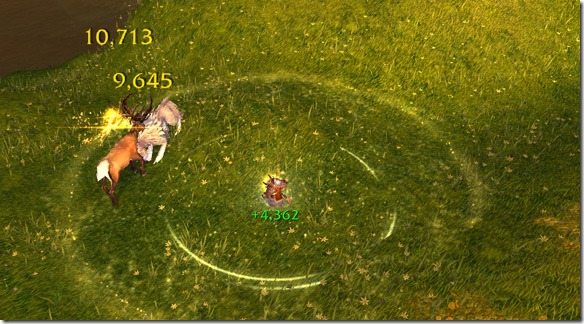
M: What about raid encounters? How about some previews for healing?
Hard to really nail this down simply. At the moment, some of the 10-man encounters have been wildly undertuned. For example, we accidentally killed Lei Shi in the Terrace of the Endless Spring due to dots when we tried to wipe/reset to get more testing/logs on the fight. Oops! Heroic Testing has just started, but has some promise to be challenging.
I will say that there are going to be some head nods to old encounters. Garalon, for example, has a Professor Putricide-esque ability requiring you to pass a DoT/Debuff around via proximity. Not “recycled” content, but certainly some “oh this reminds me of X!”.
The one that I liked the most was Imperial Vizier Zor’lok. It is one of those fights that has different abilities in each phase of the fight, and then the final phase has all the abilities active at once. I enjoy these “progressive fights”; fights in which you learn how to manage and heal each phase, and then you have a capstone in the final phase.
M: Oh man, I love Professor Putricide. Always made jokes about who was dirty and who wasn’t. Vizier sounds something like Mimiron. If I remember right, most of these encounters were for normal mode and purely for testing of mechanics.
That’s correct as the only testing so far is Normal and it really was about testing mechanics. But the tuning of the mechanics are still important. Again, if you look at Lei Shi, you’ll see the latest patch notes took that feedback and increased some of the damage she does. Hopefully she won’t be quite the pinata she proved to be originally!
M: How much will I need to work Solace into my “rotation” (for lack of a better term) to see sizeable gains along the lines of mana hymn or fiend?
D: First, I’d be remiss not to ask people to calm down about Solace. People are really getting panicked over Solace. Yes, Solace provides the most regen potential, but there is a cost to that.
When you are casting (or chain casting) PW: Solace you are doing zero healing. Those GCDs have an opportunity cost. It is up to you, to evaluate when you can fit those in and what the cost to doing that (vs healing) is. It might mean the tank takes a couple of melee swings and goes without a heal for 2-3 seconds. You’re going to have to heal that back up, but is the cost worth it? That is the question you need to ask yourself.
When you are casting (or chain casting) PW: Solace you are doing zero healing. […] It is up to you, to evaluate when you can fit those in and what the cost to doing that (vs healing) is.
Now, as far as how do you need to work Solace into rotation? You’ll want to find the gaps in damage–which can be hard the first time you see an encounter. I strongly suggest macroing PW:Solace with a mouseover/assist macro. This will allow you to simply hover over a DPS/Tank and Solace their target, all while not losing your current target (like the tank).
For PW: Solace to work out equal to Mindbender (assuming you’re also using Shadowfiend on CD) you’ll need to do 3-4 per minute (current build has it restoring 1.5%). Its actually 3.555/minute but remember its in aggregate. If for the first minute you got only 1 Solace in, to be on par by the end of minute 2, you’ll need to have 6 during minute number 2. Here is a link to an article I put together outlining how these talents work, and specifically how the granularity of the spells can work to your advantage.
I promise you, finding those GCD’s isn’t as difficult as it may seem. You just need to find the places to do it and weigh the opportunity cost.
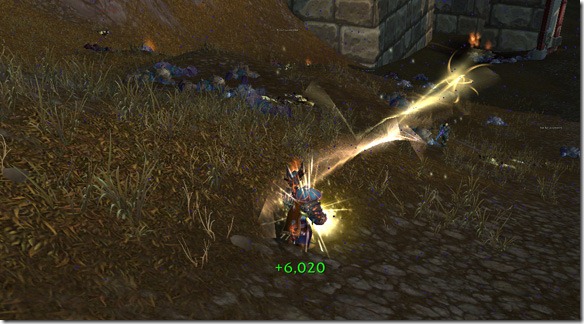
M: Right, yeah. I mean if we had access to Solace right now, we’d use it on Tendon phases during Spine (oh gosh, wouldn’t that just be so awesome to have right now?). In contrast, relying on Solace on Zon’ozz while the ball is active and bouncing around is probably a bad idea since you run the risk of losing players.
D: Yep! Finding the appropriate spots to use Solace will be the marker of a priest using it correctly. Of course, given that its clearly been under the watchful eyes of Blizzard and has been kept in check… 3-4 casts per min (in aggregate) is not a meaningless number as there may be fights where that much non-healing time is too much. However, if the Normal tests so far are any indication, you should be able to find time to cast Solace if you look for it.
Players and guilds are in a flux right now. This is going to be the time where players will be jumping around different guilds and M: situating themselves for Mists. Any advice for a 10 man Priest making the switch to 25 man and what they can expect with MoP raids?
D: 25 man raids will be interesting in MoP. I do not want to turn this into an argument about which is harder or if 25’s are dying. However, 25 man raids will have a challenge on a number of fights based purely on available real estate. A few of the fights seem to be reliant on spacing aspects like spreading out and grouping (even more so on Heroic, when looking at the Dungeon Journal). With the same square footage in the boss encounter, 25 man raids could find themselves in a position where they simply run out of space.
Healers in a 25 man raid, always need to be sure they do not have “I’m the Hero Syndrome”.
I’ve seen this happen to a number of healers when making the switch from 10s to 25s. They simply do not rely on the other 4-5 healers on their team and either: deviate from assignment, go OOM from being inefficient, or ignore instruction. You really need to work as a team in 25s, arguably more so than in 10s as you have substantially more people working with you, and covering potentially greater areas.
Be the uni-mind.
M: Let’s talk about our favourite spell Lightwell. There’s a certain cost/benefit between having it clickable vs having it firing off when player health drops below 50%. Are you going to leave yours glyphed or unglyphed?
D: Well since Lightwell and Lightspring both are healing for the same amount, the only added benefit of not Glyphing Lightspring, is that you can control its output (assuming players click it) . However, there are not many Major Glyphs we can choose from and I predict this being the glyph that we will run 95% of the time, with the 5% of the time on fights that you will ‘order’ your raid to click it at a specific time (such as Chimaeron’s Feud).
Lightspring will be ‘what’s expected’ and running it unglyphed, you likely will hear “I thought it was lightspring and would auto heal me!”
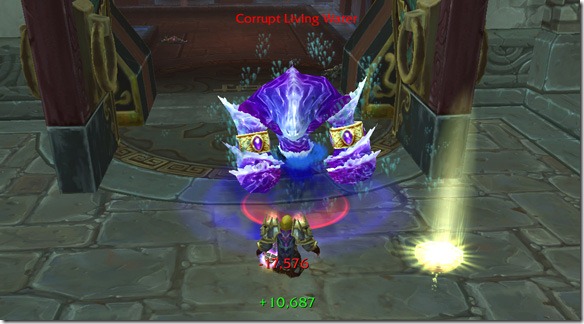
M: We were chatting briefly about the lack of Holy glyphs. It seems that there’s a certain 3-4 glyphs that are the most optimal for Holy right now. What spells would you like to see affected by glyphs for extra or altered functionality?
D: If I were to have a wish list? Whoo, boy. I’d like a glyph to allow us to channel Hymns while moving. I hate casting HoH and then having something spawn under my feet! Or perhaps something that makes Spirit of Redemption useful? I’ve always hated a talent that only is used if you die/fail. Perhaps remove the “on death” and grant something useful like an on-use throughput increase. (See Also: Archangel, Tree of Life, Ascendance, and Divine Favor)
M: Alright, that’s all I have for you, Derevka! It’s good chatting with you again and thanks for taking time out of your schedule to offer your thoughts on (what is clearly) the best class in the game. Bonus: Your MoP release date guess?
D: Well, we are in the potential final stages of testing heroic raids! I would imagine another 2-3 weeks of raid testing before we get a date. I also will assume they’re going to test LFR as well. If I were to bet, we’ll have a release date when they debut the opening cinematic at Gamescom.
I am hoping the launch date isn’t in the two weeks where I have a vacation and big work conference in September. With that in mind I am going to say 10/2/12–but I will hope it lands before. My raid team has already been tired of farming Heroic DS since February! We want something fresh, and I know many people share that opinion!
Where’s my panda?!
